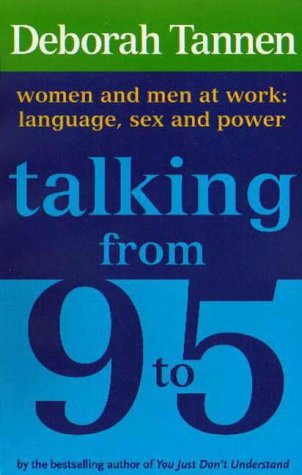Because the cover image icons on my library ebook wish lists are rather wee, I was not able to see that there is a subtitle to this book, and it explains that the book is about gendered differences in conversational styles in the workplace and how it can affect people’s professional lives. Most of my notes for this review were about my sadness that the book focused so closely on gender to the exclusion of other interesting aspects of how people talk at work (when acronyms/jargon get used, what kind of conversational accommodations are made in various settings to visitors, trainees, etc.; specifically different conversation styles with different coworkers).


Not having read You Just Don’t Understand, Tannen’s book about gendered conversational styles, I am not sure how much ground is retread in Talking from 9 to 5 (affiliate links: Amazon, B&N, Book Depository). At times Tannen seemed to be assuming some level of reader familiarity with her work, which is fine for me because my mother has read and talked about Deborah Tannen’s work before, but I can imagine it being problematic for readers whose first encounter with her is this book.
Tannen is careful to avoid the whiff of gender essentialism that can hover around a book dealing with gender. Throughout the book, she emphasizes repeatedly that the typically “female” and “male” conversational patterns she describes among mostly middle-class working people are not due to any inherent difference between women and men, and are far from universal. Rather, she argues that the genders are socialized differently and rewarded by their peers for different speech patterns and behaviors. These behaviors are not “correct” except in their own context; they are rituals that work as long as everybody present recognizes and follows the rituals.
(Workplace conversational rituals, by the way, could have been the entire book as far as I am concerned. Like everyone at meetings thanking everyone else at meetings, and people bitching about the coffee no matter what the coffee is like.)
Here is a point Tannen made that I love (forgive the long quotation):
The term “marked” is a staple of linguistic theory. It refers to the way language alters the base meaning of a word by adding something — a little linguistic addition that has no meaning on its own. The unmarked form of a word carries the meaning that goes without saying, what you think of when you’re not thinking anything special…
I was able to identify the styles and types of the women at the conference because each of us had to make decisions about hair, clothing, makeup and accessories, and each of those decisions carried meaning. Every style available to us is marked. Of course, the men in our group had to make decisions too, but their choices carried far less meaning. The men could have chosen styles that were marked, but they didn’t have to, and in this group, none did. Unlike the women, they had the option of being unmarked…
I asked myself what style we women could have adopted that would have been unmarked, like the men’s. The answer was: none. There is no unmarked woman. There is no woman’s hairstyle that could be called “standard,” that says nothing about her. The range of women’s hair-styles is staggering, but if a woman’s hair has no particular style, this in itself is taken as a statement that she doesn’t care how she looks — an eloquent message that can disqualify a woman for many positions.
And you know, I love my clothes. I love all the different types of outfits I can do, and how you can dress outfits up or casual them down depending on what you’re in the mood for that day or what kinds of meetings you’re going to be attending. I like having the freedom to do that. I would also like to be able to choose freedom from doing that. There are days when I would like to have that option. (NB: Freedom to/freedom from distinction is stolen from Margaret Atwood.)
As insightful as she can be, Tannen occasionally crosses over the line that divides description from prescription, and when that happens, it tends to be aimed at women, not at men. Women could be more outspoken in meetings; women could stop hedging their ideas with disclaimers; etc. Of course this is true. But if, as Tannen has repeatedly said, the problem is not one style being more correct than another style, but rather a clash among differing styles each of equal value, then men could adapt to more typically female conversational styles as well as the other way around.
It’s a minor nitpick in an interesting book. As ever, I’m fascinated by analyses of conversation, and I’m glad to have encountered this book and reminded myself of the existence of Deborah Tannen.
Cover report: American cover wins! I do not feel the British cover is making an effort.